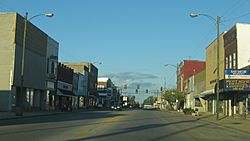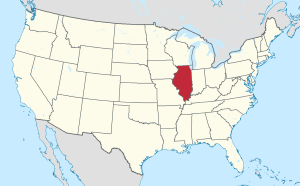Flora, Illinois facts for kids
Quick facts for kids
Flora
|
|
|---|---|

Downtown Flora
|
|
| Motto(s):
"Good things happen when good people work together"
|
|

Location of Flora in Clay County, Illinois.
|
|

Location of Illinois in the United States
|
|
| Country | United States |
| State | Illinois |
| County | Clay |
| Area | |
| • Total | 4.69 sq mi (12.15 km2) |
| • Land | 4.69 sq mi (12.15 km2) |
| • Water | 0.00 sq mi (0.00 km2) |
| Population
(2020)
|
|
| • Total | 4,803 |
| • Density | 1,024.09/sq mi (395.37/km2) |
| Time zone | UTC-6 (CST) |
| • Summer (DST) | UTC-5 (CDT) |
| ZIP Code(s) |
62839
|
| Area code(s) | 618 |
| FIPS code | 17-26454 |
| Website | City of Flora, Illinois |
Flora is a city located in Clay County, Illinois, in the United States. In 2020, about 4,803 people lived there.
Contents
Discovering Flora's Past
Flora was founded by a man named Samuel White. He was born in Ohio in 1831. Samuel and his family moved to Clay County in 1852. He bought 85 acres of land from the State of Illinois.
The town of Flora was officially planned in February 1854. Samuel White worked with Ethelred Nixon and John Brown to lay out the town. They chose a spot that was 85 acres large.
Before Flora, there was a small village called Mooresville nearby. Over 100 lots were sold there, and some buildings were put up. But Mooresville didn't last. Its main house was moved to Flora and became known as the "Commercial House."
Samuel White was very generous to Flora. He gave land for the city park, which is now called Library Park. The Flora Public Library stands there today. He also donated land for the first schoolhouse, the Baptist Church, and its parsonage. Streets and alleys in the original town were also built on land he gave. Samuel White passed away in 1912 and was buried in Flora.
Flora's Location and Weather
Flora is located at 38°40.2′N 88°28.5′W / 38.6700°N 88.4750°W. It covers an area of about 4.69 square miles (12.15 km2), and all of it is land.
Flora's Climate: Temperatures and Rain
| Climate data for Flora, Illinois, 1991–2020 normals, extremes 2000–present | |||||||||||||
|---|---|---|---|---|---|---|---|---|---|---|---|---|---|
| Month | Jan | Feb | Mar | Apr | May | Jun | Jul | Aug | Sep | Oct | Nov | Dec | Year |
| Record high °F (°C) | 70 (21) |
76 (24) |
85 (29) |
89 (32) |
95 (35) |
105 (41) |
107 (42) |
102 (39) |
101 (38) |
95 (35) |
83 (28) |
72 (22) |
107 (42) |
| Mean maximum °F (°C) | 61.3 (16.3) |
66.6 (19.2) |
75.5 (24.2) |
83.9 (28.8) |
90.3 (32.4) |
96.1 (35.6) |
97.0 (36.1) |
96.3 (35.7) |
94.3 (34.6) |
86.8 (30.4) |
74.1 (23.4) |
64.6 (18.1) |
99.0 (37.2) |
| Mean daily maximum °F (°C) | 38.8 (3.8) |
44.2 (6.8) |
54.5 (12.5) |
67.1 (19.5) |
76.8 (24.9) |
86.0 (30.0) |
89.0 (31.7) |
87.8 (31.0) |
81.6 (27.6) |
69.0 (20.6) |
54.8 (12.7) |
43.2 (6.2) |
66.1 (18.9) |
| Daily mean °F (°C) | 30.0 (−1.1) |
34.5 (1.4) |
43.8 (6.6) |
55.3 (12.9) |
65.5 (18.6) |
74.7 (23.7) |
77.4 (25.2) |
75.6 (24.2) |
68.5 (20.3) |
56.6 (13.7) |
44.2 (6.8) |
34.5 (1.4) |
55.1 (12.8) |
| Mean daily minimum °F (°C) | 21.2 (−6.0) |
24.7 (−4.1) |
33.0 (0.6) |
43.5 (6.4) |
54.1 (12.3) |
63.3 (17.4) |
65.8 (18.8) |
63.4 (17.4) |
55.4 (13.0) |
44.3 (6.8) |
33.6 (0.9) |
25.9 (−3.4) |
44.0 (6.7) |
| Mean minimum °F (°C) | 1.9 (−16.7) |
5.6 (−14.7) |
17.5 (−8.1) |
29.7 (−1.3) |
39.9 (4.4) |
53.3 (11.8) |
57.1 (13.9) |
54.6 (12.6) |
44.3 (6.8) |
30.6 (−0.8) |
19.7 (−6.8) |
10.6 (−11.9) |
−0.7 (−18.2) |
| Record low °F (°C) | −14 (−26) |
−9 (−23) |
2 (−17) |
23 (−5) |
34 (1) |
41 (5) |
51 (11) |
47 (8) |
36 (2) |
24 (−4) |
6 (−14) |
−7 (−22) |
−14 (−26) |
| Average precipitation inches (mm) | 2.95 (75) |
2.54 (65) |
3.83 (97) |
5.31 (135) |
5.09 (129) |
5.86 (149) |
4.19 (106) |
3.73 (95) |
3.34 (85) |
3.67 (93) |
4.23 (107) |
3.26 (83) |
48.00 (1,219) |
| Average snowfall inches (cm) | 3.1 (7.9) |
3.2 (8.1) |
0.8 (2.0) |
0.0 (0.0) |
0.0 (0.0) |
0.0 (0.0) |
0.0 (0.0) |
0.0 (0.0) |
0.0 (0.0) |
0.0 (0.0) |
0.0 (0.0) |
4.5 (11) |
11.6 (29) |
| Average precipitation days (≥ 0.01 in) | 7.2 | 7.5 | 9.7 | 9.4 | 12.1 | 10.2 | 7.9 | 7.3 | 6.5 | 8.4 | 8.7 | 9.0 | 103.9 |
| Average snowy days (≥ 0.1 in) | 1.8 | 1.5 | 0.2 | 0.0 | 0.0 | 0.0 | 0.0 | 0.0 | 0.0 | 0.0 | 0.0 | 1.3 | 4.8 |
| Source 1: NOAA | |||||||||||||
| Source 2: National Weather Service (mean maxima/minima 2006–2020) | |||||||||||||
Flora's Population Over Time
| Historical population | |||
|---|---|---|---|
| Census | Pop. | %± | |
| 1860 | 456 | — | |
| 1870 | 1,339 | 193.6% | |
| 1880 | 1,494 | 11.6% | |
| 1890 | 1,695 | 13.5% | |
| 1900 | 2,311 | 36.3% | |
| 1910 | 2,704 | 17.0% | |
| 1920 | 3,558 | 31.6% | |
| 1930 | 4,393 | 23.5% | |
| 1940 | 5,474 | 24.6% | |
| 1950 | 5,255 | −4.0% | |
| 1960 | 5,331 | 1.4% | |
| 1970 | 5,283 | −0.9% | |
| 1980 | 5,379 | 1.8% | |
| 1990 | 5,054 | −6.0% | |
| 2000 | 5,128 | 1.5% | |
| 2010 | 5,070 | −1.1% | |
| 2020 | 4,803 | −5.3% | |
| U.S. Decennial Census | |||
In 2020, Flora had 4,803 residents living in 1,984 households. About 1,115 of these were families. The city had about 1,024 people per square mile.
Most people in Flora (92.30%) were White. There were also small percentages of African American, Native American, and Asian residents. About 2.42% of the population identified as Hispanic or Latino.
About 23.3% of households had children under 18. Many households (40.73%) were married couples. The average household had 2.82 people. The average family had 2.26 people.
The median age in Flora was 41.7 years. This means half the people were older than 41.7 and half were younger. The median household income was $49,722. For families, it was $60,660.
Flora's Economy and Jobs
In September 1960, Flora was called "Ford Town USA." About 1,500 car owners were given a new Ford car or truck to drive for a week. This was a special event for the city.
Flora's main business is farming. The city is surrounded by rolling countryside. About 80-85% of this land is used for farming and raising animals. There are also companies in Flora that employ many people.
The Historic Flora B&O Depot
The Flora B&O Depot was a very important building for the city. The first depot was built in 1872. Local citizens helped a lot to build it. Sadly, this building was destroyed by fire in 1916.
A new, bigger three-story brick depot was built in 1916–1917. This new building was central to Flora's economy. In the 1920s, the railroad employed half of Flora's workers. By 1924, 300 people worked at the local station.
The main floor of the depot was for passengers. It had a large waiting room, a baggage room, and restrooms. The Western Union office and ticket office were also on this floor.
The second floor held offices for important railroad staff. These included the chief clerk, engineers, and supervisors. Even railroad police and the district's doctor had offices here.
The third floor had large offices that later became a social room. Railroad employees and their families held dinners and parties there. The depot was not just for travel; it was a community hub.
In the 1950s, cars became more popular as roads improved. People stopped using trains as much. The depot became less important. The days of 12 passenger trains passing through Flora daily became a memory.
In 1998, the Flora B&O Depot was added to the National Register of Historic Places. This means it's a special building with historical value. The Flora Community Development Corporation (FCDC) bought the depot.
The FCDC got grants and local donations to restore the building. Today, the University of Illinois Extension Service uses the third floor. The second floor is a community room that can be rented. The first floor has the Flora Chamber of Commerce office and a museum with local history.
Flora's "Barbed Wire Choir"
In 1987, some Flora officials formed a group called the "Barbed Wire Choir." They made a music video to try and get a state prison built in Flora. The song featured city officials, including the mayor. They sang to the governor, asking if they would get a prison.
The video was shown on local TV. Then, it gained national attention on shows like MTV and Good Morning America. Even The Late Show Starring Joan Rivers showed it! However, Flora did not get the new prison.
Notable People from Flora
- Tim Tetrick – A famous harness racing driver.
- Mad Man Pondo – A professional wrestler.
- John Powless – A successful basketball and tennis coach at the University of Wisconsin. He was also a tennis champion.
- Bill Ernest – A former President and Managing Director for Walt Disney Parks & Resorts in Asia.
- Emily Bailey – A contestant on the reality TV show Road Rules: USA – The Second Adventure.
Images for kids
See also
 In Spanish: Flora (Illinois) para niños
In Spanish: Flora (Illinois) para niños





